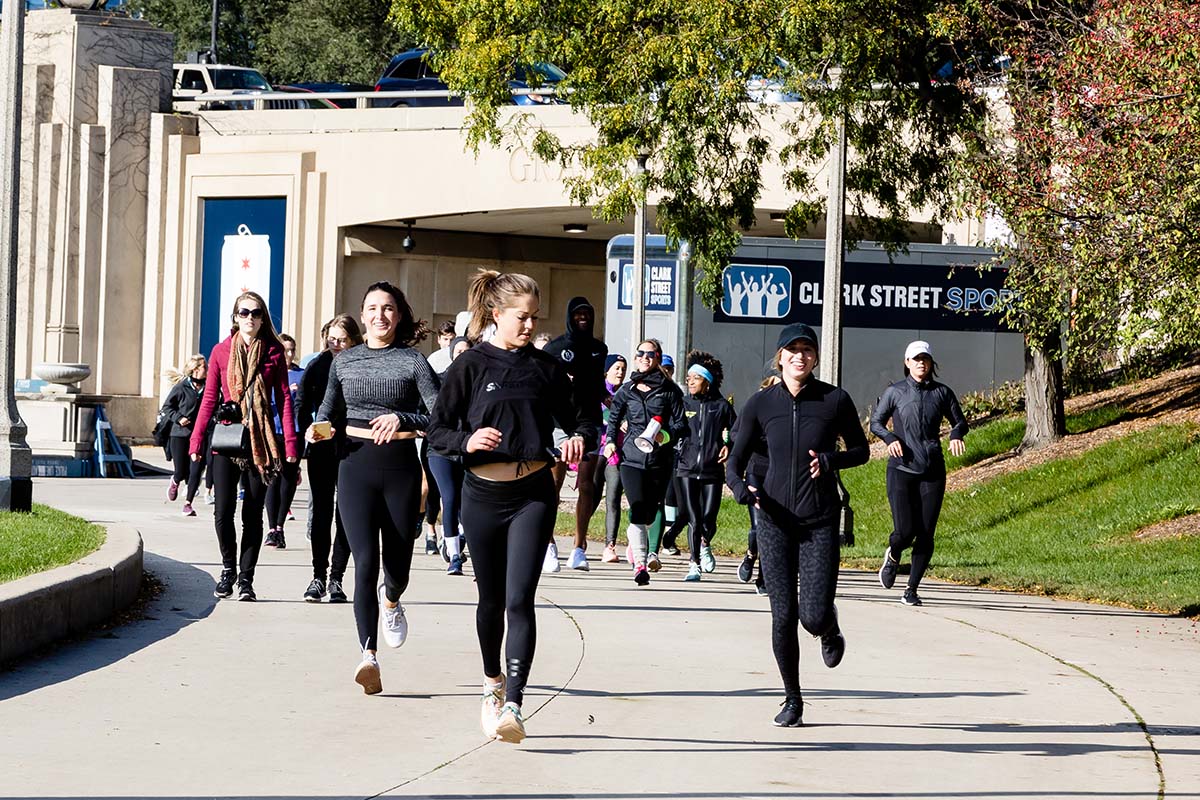What Actually Happens When You Experience Runner’s High

The door closes behind you, leaving miles of pavement between you and your return home. Transitioning slowly from a walk to a brisk jog, a mantra brings rhythm to your steps: “one foot in front of the other.” But slowly, a new thought enters your head, “Why am I doing this?” Or, more accurately, “Why” (step) “am” (step) “I” (step) “do” (step) “ing” (step) “this?”
At the 30 minute mark, you feel something: a reduction of pain, a second wind, euphoria. Ah, yes, the runner’s high. And if you google, “What causes runner’s high?” The most cited cause is the trusty endorphin (and yes, it is tempting to quote Legally Blonde here, but I shan’t because that joke is easy and this is a science-y article, so I’ll work a little harder for my jokes).
But newer research published in The Journal of Experimental Biology titled “Wired to Run: exercise-induced endocannabinoid signaling in humans and cursorial mammals with implications for the ‘runner’s high’” notes that you can thank a different system in your body for the experience of euphoria after a long, hard workout: The Endocannabinoid system.
If you’ve met me, you know that I can become borderline obsessive – ok, regular obsessive – when I’m fascinated by a topic. And recently, I’ve had weekly sessions wherein I tap into the knowledge that Dr. James Lowder and Vassilli Kotlov gained as they worked in pharmaceutical research studying the endocannabinoid system before they went on to become Chief Medical Officer and CEO of Impact Naturals, respectively. In my head, I call it CBD-school.
Where we last left off with the endocannabinoid system, we discussed what scientists now believe about the system. TL;DR: All of us have tiny cannabis-like molecules floating around in our brains and that the endocannabinoid system goes to work after trauma – both physical and emotional.
And at the end of a conversation we had a couple of weeks ago, Kotlov dropped a bomb, “Did you know that runner’s high is actually related to the endocannabinoid system?” It was like the life-changing question a therapist asks you right before declaring, “and that’s time.”
What is runner’s high?
According to Wired to Run, the definition of runner’s high is a change in any of the following observable phenomena after an extended period of intense exercise: reduced pain sensation, anxiolysis (aka anxiety relief), sedation, or feelings of well being. That’s an important note because runner’s high was popularized as an actual head-in-the-clouds euphoria, rather than your body’s attempt to mask your anguish during hard work.
So what is the purpose of runner’s high?
Plainly, as Kotlov states it, “we’re just freaking animals.” And that sentence is a strong candidate for printing on a t-shirt. But more importantly, within that sentence are the evolutionary implications of runner’s high.
The theory behind runner’s high is that it exists to encourage predatory animals *like humans*, to go beyond their own territory to find prey. This was Mother Nature pushing us to keep looking when resources were scarce.
More from National Geographic on that: “You’d expect if running long distances is important for our ancestors to hunt and gather, there should be a feedback mechanism to help people do that-and runner’s high is a kind of [positive] feedback.”
But I thought that endorphins cause runner’s high?
Recently published research by a group of scientists in Germany put this long-standing theory to the test.
And why the theory was tested is also an interesting thought avenue we could take a little trip down: From The New York Times, “Endorphins cannot cross the blood-brain barrier, because of their molecular structure. So, even if runners’ blood contains extra endorphins, they will not reach the brain and alter mental states.”
Before I blow your mind, some background: Endorphins are classified as endogenous opioids, meaning that they are chemically similar to the drugs that we’ve classified as opioids. That means that opioids, like pain medications, and endogenous opioids act on the same receptors in your brain.
Stay with me. I told you that to tell you this. In this double-blind German study, the researchers treated half of the willing and fully consenting human subjects with Naltrexone and then asked them to run. Naltrexone, by the way, is an “opioid receptor antagonist” that blocks the action of opioids in your brain.
The theory being tested was if endorphins cause runner’s high, no one treated with Naltrexone should experience it.
The study found that after 45 minutes of running on a treadmill, “Opioid blockade did not prevent the development of euphoria and reduced anxiety as well as elevation of eCB [endocannabinoids] levels following exercise.”
This new and exciting research changes our understanding of why we want to keep running even if it’s challenging.
Or to quote The New York Times’ writer Gretchen Reynolds who reported on the study, “The findings expand our understanding of how running affects our bodies and minds, and also raise interesting questions about why we might need to be slightly stoned in order to want to keep running.” (See previous sentence for a hard working, science-y joke)
What does the endocannabinoid system have to do with Runner’s High?
To hear Dr. Lowder and Kotlov explain it, running, as a thought experiment, doesn’t make any sense. There’s a higher energy cost and an increased injury risk. All of that exertion and hard work is interpreted by your endocannabinoid system as trauma, just like if you were having an intestinal issue or if you’d stubbed your toe in the middle of the night on your bed frame – again.
And just like we learned in our exploration of the endocannabinoid system, when your body experiences trauma, your endocannabinoid system reacts to it, releasing chemicals that are meant to return your body to homeostasis.
So imagine that trauma occurring one quick step after another for about 45 minutes. Your body will respond with a flood of endocannabinoids.
From Wired to Run, “We show that humans and dogs share significantly increased exercise-induced eCB [endocannabinoid] signaling following high-intensity endurance running.” They also note that similar periods of low-intensity exercise don’t produce the same benefits. I don’t want to dive too deep into this point, but yes, you read that correctly, dogs experience runner’s high too.
And when our bodies send endocannabinoids to thwart trauma, your body enacts a system to clean up the extra endocannabinoids after. To quote my own writing here, “the excess endocannabinoids that our body creates in response to trauma are eliminated by a lot of science – Fatty acid amide hydrolase (FAAH) and Monoacyl glycerol (MAG) lipase – breakdown AEA (anandamide) and 2-AG, respectively. Consider these guys – FAAH and MAG- the clean-up crew.” And CBD and CBG act to slow that process.
That’s important because supplementing with CBD/CBG pre-workout can make your runner’s high last longer, which in turn, could potentially help you to run or work out longer. For that kind of self-experimentation, we recommend Revive or Restore from Impact Naturals. Lowder suggests you might “take 1 or 2 capsules as you stretch out to start running (or, your chosen form of activity), as the endocannabinoid system becomes activated within the first 30 minutes of exercise”. Kotlov, himself an endurance road cyclist, says he takes one Revive before he starts a long ride, and one Restore afterwards.
Ready for more on the endocannabinoid system? After our last conversation Kotlov and Dr. Lowder sent five peer-reviewed research papers on the endocannabinoid system and sex, so stay tuned for that.












